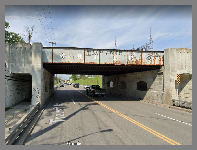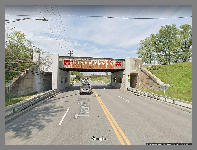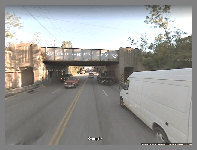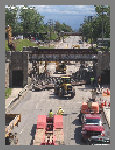"THE NEW CITY OF DEPEW"
By: Scott MP Hawbaker
| 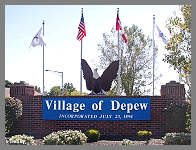 |
This handsome sign welcomes drivers to the Village of Depew on the corner of Broadway and Borden Road. At a glance, one is given a small piece of the history of Depew with the proclamation of its incorporation on July 23th, 1894. Some older residents may remember the significance the name or incorporation date, but most travelers have no idea of the rich railroad history attached to the name or how the "New City of Depew" came to be. |
| One of the earliest settlers in the area was Appolos Hitchcock of Welch descent who came in 1808, from Connecticut. He purchased his farmland 8 miles east of Buffalo in the town of Amherst (now Cheektowaga) in 1809 from the Holland Land Company. It was a stretch of wide open farm fields with mud and dirt roads. He then constructed a log house on the creek flats of what is now Borden Road. He moved his entire family and belongings from the city of Buffalo on an ox-drawn sled/wagon to their new home in June of 1811, becoming the first recorded permanent settler. 1 |
| He served as a liaison and agent between the Holland Land Company and the lands of the Buffalo Creek Indian Reservation, of "Jukdowaageh" (later "Chictawauga," then "Cheektowaga"). Hitchcock died in July of 1922 and is buried in Lancaster Rural Cemetery. Depew Historian Theresa Wolfe said "Hitchcock built a sawmill, a gristmill and a whiskey distillery," and a drive off Como Park Boulevard now bears his name. Depew forefathers also gave a nod to Joseph Ellicott who created the Holland Land Company and laid the boundries of our eight Western New York counties. Hitchcock used his distillery for the purpose of converting the Indian's surplus corn into liquor. |
| 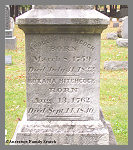 |
| Early German settlers, many of whom came in the 1820s and '30s, were farmers. Surnames of early settlers include Gangloff, Zurbrick, Koons, Waltz, Weimer, Durringer, Lux, Pjohl, Fath, Ratzel, Monin, Schlenker, Fernback, Abendscheim, Zugg, Zimmett, Raynor, Schwarts and Ott. The Dutch settled in Lancaster and Depew in the mid-1800s. Polish immigrants arrived in the area before 1865. By 1874 there were 150 Polish families in Buffalo (early geographical boundaries were vague; and so were the exact number of Poles residing in the vicinity of Depew).2 |
| This all changed when Chauncey M. Depew5 came to the rural community 1893, at the peak of the Industrial Age. As president of the New York Central Railroad he built the company headquarters in what many called "The New City of Depew."2 Depew and fellow investors formed the "Depew Investment Company" and purchased 1,000 acres of land north and south of the NYC tracks for their enterprise.3 The purpose of the Syndicate was to sell industrial sites, and homes for workers near their jobs. |
| 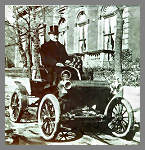 |
| One industry after another moved into Depew and clusters of homes were built around each. This group of investors envisioned the area as a prominent center of commerce as an integral rail link on the lines between Chicago and New York City. This vision was enhanced by the area's proximity to Buffalo, which at the time was 2nd largest railroad center in America. By 1893, more than 250 trains entered and left the city each day. Depew viewed this area as a profitable place to invest. |
| 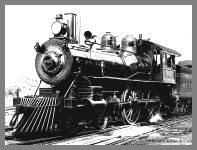 |
Construction of the New York Central shops turned more interest to the area. Locals began referring to it as "The place where Depew is building."4 By 1893, the New York Central & Hudson River Railroad Locomotive Works, National Car Wheel Works, and Gould Coupler Company - 1891, site of the infamous "Gould Coupler Strike of 1914." |
| The Union Car Company, and Gould Storage Battery Company were built and in operation by 1897, with a promise of more to come. The locomotive works would employ 1,500 men in the repair and manufacturing of locomotives for all the Vanderbilt controlled railroads. That same year, a syndicate was formed by a group of Buffalo and New York City financiers known as the "Depew Improvement Company." Shares were sold at $100 each and when incorporation papers were signed, and $1,500,000 in capital was raised. The major stockholders included Chauncey M. Depew, Charles A. Gould, John J. Albright, George Urban, Wilson Bissell and John Jacob Astor.6 |
| 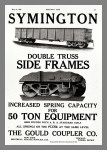 |
| When residents organized to plan the future of their booming community, it seemed only natural to name it after the man who spurred its creation. The "Village of Depew" was incorporated July 23rd, 1894. First elected officers were Dr. William Fairbanks, president; John Zurbrick, George Waltz, John Graney and Anthony Hartung, trustees; Martin Keifer, tax collector and J.N. Oswald, village clerk. 3 As one industry after another moved into Depew, clusters of homes were built around each factory. This is the reason that the Village developed in scattered communities, rather then being centralized around a single downtown shopping section. |
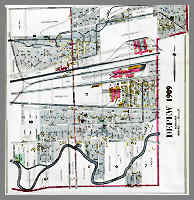 |
| Main Street in Village could have been called "downtown" at one time but it was only 3/4's of a mile long stretching from Neoga Street to Wyandotte Street at the Lancaster end. However in that short distance Main Street featured a movie house, grocers, butchers, company banks, boarding houses, shopkeepers and of course numerous saloons. Depew also had two trolley lines to shuttle workers from Buffalo to the locomotive shops and other factories. |
| In 1893, a a group of wealthy businessmen started construction of the "Buffalo, Bellevue & Lancaster Electric Railway"7 to bring workers from the city to their jobs in Depew. Known as the "Depew Branch," it came into the Village from the west, along what is now Como Park Blvd., then north parallel to Transit Rd. on South Bellevue Ave., behind Grasso's Pizza (McDonalds), then east on Terrace Blvd., north on Sanilac Street, east on Sawyer Ave., through the lands of the Depew Improvement Company and into the Sawyer/Laverack tract through the Village of Lancaster.2 |
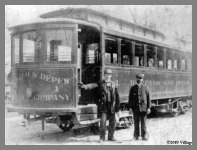 |
In 1897, Buffalo businessman Herbert P. Bissell and partners obtained a charter for the "Buffalo & Depew Electric Railway" which would be double tracked for efficiency both east and westbound. Construction began in 1899 and opened for passengers on May 8, 1901. The line began on Genesee Steet in Buffalo and ran 7-1/2 miles east through north Depew along its own right of way called "Buffalo Depew Boulevard." It then ran south crossing French Road onto what became Sherwood Court. |
| A large coal burning, electrical power house was built on the northeast corner of Sherwood Ct. and Burkhardt Avenue to generate electricity for the line. It then traveled east under the Lehigh Valley Railroad to Transit Road along what became George Urban Blvd. The line then went south on Transit Road passing the "Depew Inn," (which burned down in 1910 and site of DeVille Motors today) at the northwest corner of Transit Road and Harvard Avenue. The line then traveled east along Ellicott (Walden Ave.), then north on Lincoln Street to Olmstead Ave and ended at the intersection of Burlington and Ellicott Rd (Walden Ave.). Here we have pictured the Buffalo Depew Electric Railway Powerhouse that was built in 1897 located on the corner of Buffalo Depew Boulevard (now Sherwood Court) and Burkhardt Avenue. On June 6, 1931, the last trolley left Buffalo for Lancaster.8 |
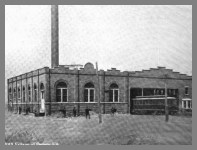 |
| Following are streets we still travel today that honor Depew's founding fathers and the railroads that served Depew. Gould Avenue (Charles A. Gould - Founder and President of Gould Coupler Company and Gould Storage Battery Companies), Vanderbilt Avenue (Cornelius Vanderbilt - President of the New York Central Railroad), George Urban Blvd. (George Urban Jr. - Major stockholder of the Depew Improvement Company), Olmstead Avenue (Frederick Law Olmsted - Architect of the design of Depew Town square), Ellicott Place (Joseph Ellicott - Created the eight counties of WNY. Walden Avenue was Ellicott Road until the late 60's), Erie St (ERIE Railroad now Norfolk Southern Railroad), Lackawanna Ave (Delaware Lackawanna & Western Railroad now Depew Lancaster & Western - 2.91 miles of track from Lancaster to Depew), and Lehigh Court (Lehigh Valley Railroad all the tracks are now gone. Some folks now call the land where the LV Niagara Junction was, "Mini-ville" or "Iron Bridge"). |
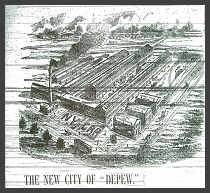 |
"The New City of Depew," New York was envisioned as out rivaling Pullman, Illinois; Altoona, Pennsylvania; or Sayre, Pennsylvania in the manufacture and repair of railroad related items. Land surveys were conducted by Ricker & Wing of Buffalo who hired the world renowned city planner and landscaper Frederick Law Olmstead as consulting architect who designed Depew Village Park where the Post Office is located today. By 1897, the Village of Depew had over 2,500 inhabitants.3 Other railroad related industries to locate there included: Union Car Shops, Gould Coupler Company, Buffalo Brass Company, and the National Car Wheel Company. In 1900, Depew gained the dubious distinction of having more bars per capita than any other village, town or city in the United States. The hardworking railroad men from Depew and Buffalo, who needed a place to quench their thirst, could find a bar an every corner! |
| Depew would have its own water supply by pipeline from Lake Erie, paved roads and electric lighting would be exclusively used instead of gas. There would be a post office, hotel, banks, churches, schools, and business establishments. "The New York Central Railroad ran special trains between Depew and Buffalo for the convenience of those employed in the shops and the army of workmen engaged in the erection of new buildings and houses."2 |
| Four major railroads crossed a portion of the land tract owned by the Depew Improvement Company insuring its success as a railroad equipment manufacturer. Those being the New York Central Railroad, Lehigh Valley Railroad, Erie Railroad, and Delaware, Lackawanna & Western Railroad. |
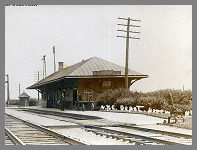 |
By 1909, Depew boasted three railroad passenger Depots within 1/2 mile of each other just off of Transit Road. The New York Central Depot was located near the corner of Walden (then Ellicott Road) and west of Transit on the south side of their tracks. (A Verizon Cellular Phone store sits there now) |
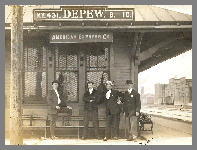 |
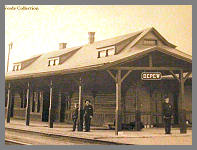 |
The Lehigh Valley Depot was also just west of Transit on the north side of their tracks. An access road still leads to the area where the Lehigh's Niagara Junction tower once stood. Passengers from either the Lehigh Valley or the New York Central Railroad's, could walk a few hundred feet across the tracks, to access either Depot. |
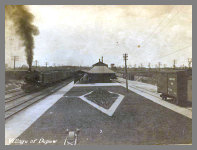 |
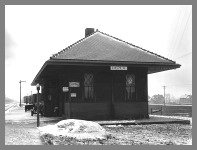 |
The Erie Depot was a little further south off the east side of Transit and Gould Avenue on Erie Place. Erie Place is now a dead end street, but before 1937, it connected directly to Transit Road before the bridges were built. The DL&W did not have a Depot in Depew at this time but had one in Lancaster just off Central Ave. |
| The three depots are long gone, but three of bridges, built in 1937, that cross Transit Road still remain. Using Google Maps Street view, and a little photo shoping, I have compiled what you see today on a half mile trip northbound on Transit from Broadway. Unfortunately, the Lehigh Valley bridge was removed in 2017 but a "look back" on Google Maps to 2007, still shows the bridge. (New York) Central Avenue in the Village/Town of Lancaster still has all four bridges. |
| The Village of Depew, New York grew and prospered until 1931 when the NYC Railroad, during the Great Depression, decided to close the locomotive shops after 38 years (1893-1931) sending the work to Albany, NY. and Avis, Pennsylvania. Bigger steam locomotives were being built and it was too costly to re-tool the old machinery. Many men were offered jobs at these locations and they would commute back to Depew each weekend by train. The 1914 Strike at the Gould Coupler Company took its toll on finances, so in 1925, Charles A. Gould was forced to sell a controlling part of the Coupler Company and Gould Storage Battery Company to the Symington Company, becoming Symington-Gould.10. |
During World War II, the plant converted to the manufacture of bomb casings and military tank components. Symington-Gould purchased the Wayne Pump Co. in 1958, a manufacturer of gasoling pumps and service station pumps. It became Symington-Wayne Corp. In 1968, Dresser Industries purchased Symington-Wayne and formed the Dresser Transportation Division. The foundry continued to make large and small cast metal parts. The Depew plant closed in 1985.11
Today, parts of the campus are used by various businesses. In time, the other railroad related industries closed and the Village of Depew would no longer be the "Railroad Town" that it once was. Other types of businesses took their place over time and today, this village of over 15,000 people, is over 125 years young. |
| At the turn of the last century, every village, town and city had a railroad Passenger Depot and or Freight Station. Depew had three and the City of Buffalo over ten. Today, Western New York has only three active Passenger Depots. One in Niagara Falls, A newly rebuilt in 2019, 27.7 million dollar station on Exchange Street near Canalside in Buffalo and our one in Depew. |
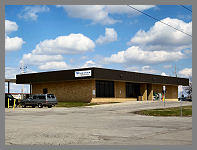 |
Chauncey M. Depew's name lives on as Amtrak© trains crossing the Empire State stop at 55 Dick Road near Broadway, for the station in Depew. Amtrak© could not afford to rehabilitate the historic Buffalo Central Terminal so a new "modern" station, which would be more cost effective, was constructed starting in early 1979. The last train to call at Central Terminal was the westbound Lake Shore Limited, which departed at 4:10 am on October 28, 1979. Service at the new Buffalo/Depew station began that same day.9 |
| Over 100,000 passengers boarded or detrained at Depew in 2019. A plaque on the trackside wall was installed by the Western New York Railway Historical Society, on May 10th, 1993. It gives visitors a glimpse into the past where nearby, on May 10th, 1893, NYC "Empire State Express" Locomotive #999 attained a top speed of 112.5 miles per hour, making it the fastest locomotive of its time. |
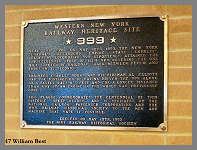 |
| Sadly, few know the rich history of how Depew got its name. Happily, now you can share the story of how Chauncey M. Depew, put us on the map with his "New City of Depew." |
ENDNOTES:
1. Apollos Hitchcock - "Find A Grave," Cheektowaga Cavalcade Centennial booklet, Maureen Gleason, 2013.
2. "The New City Of "Depew,""Buffalo Morning Express 17 April, 1892.
3 . Village of Depew History - Depew Bee, July 14th, 1994 edition.
4. "What They're Doing At Depew," Buffalo Morning Express 16 April, 1893, p. 12.
5. WNYRHS Roll of Honor - "Chauncey M. Depew" - Railway Flyer, 2005, July.
6. Fess, Margaret. "Depew Has Expansion Room." Buffalo Courier Express 16 September, 1960. Erie County History Scrapbook, Buffalo and
Erie County Public Library, Vol 4, p.94.
7. "Bellevue Cheektowaga Historic Rails to Trails" - Construction of the Buffalo-Bellevue-Lancaster Electric Railway Trolley Line.
8. "Next Stop, Depew" - Construction of the Buffalo & Depew Electric Railway, Buffalo Rising.
9. Amtrak© Depew - Wikipedia.org, March 2022.
10. Symington Gould Corporation - Rochester Public Library, June 7th, 2018.
11. Western New York History - The Lancaster Legend, 1997, Terry Wolfe.
OTHER REFERENCE SOURCES:
"Chauncey M. Depew Dies Of Pneumonia In His 94th Year." New York Times 5 April, 1928, pp. 1 & 27.
"Chauncey Depew Dies At Age 94, 1928," p.1. Buffalo Courier Express 5 April, 1928.
"Notables Of Nation Pay Tribute To Noted Orator." Buffalo Courier Express 6 April, 1928, p. 5. |




